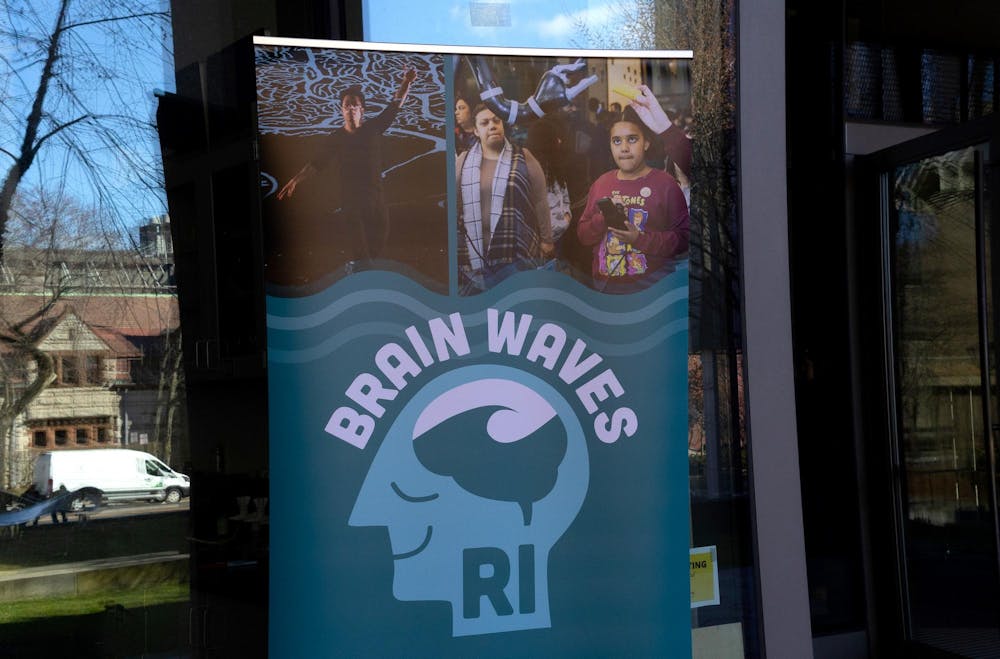Young minds from the Providence community came to Brown this Saturday for interactive lessons about neuroscience at the annual Brown Brain Fair. Organized and hosted by student group Brown Brain Bee and the Department of Neuroscience, the fair is a public event for community members of all ages to learn about neuroscience in an introductory atmosphere.
“It’s cool because there’s so much science stuff that we can do,” said Sarah, age seven, wearing a pipe cleaner and colored yarn bracelet with beads that “make a pattern that represents neurons.” When asked if she was interested in science, she nodded. Why? “It’s fun!”
The event included a range of activities. With popcorn in hand and brain-themed face paint on, attendees could walk through tables showcasing neuroscience-related labs at Brown and learn about topics like sleep or emotions through interactive activities.
According to Jacqueline Cho ’24, Brown Brain Bee’s president, the goal was to create “interactive experiences” to help attendees make their own connections to “make that complex understanding more simple for themselves.”
One lab featured at the Brain Fair was the Fleischmann Lab, which studies the sense of smell. In essence, “how do we take molecules that are binding and physical in nature, and then go through the circuitry to create odor objects such as ‘banana’ or complex objects like ‘coffee?’” explained first-year neuroscience PhD student Rebecca Tripp GS.
At the Brain Fair, these complex processes were made into a “hands-on” experience. To do so, Tripp brought tubes containing various scent molecules that participants could sample and then try to guess what they were.
“This is one of my favorites,” Tripp said, handing a tube labeled ‘B’ to a young boy. “What do you think it is?” she asked. He pointed to a photo on a trifold and exclaimed, “It’s banana!”
“You might have noticed that it smells more like Laffy Taffy than traditional banana, and that's because this is (only) one of 40 smells that … bind and create the object of ‘banana’ in our brain,” Tripp explained.
Tripp, who previously worked with kids, said she enjoys these types of events because of how “inquisitive” the children are.
“It's cool to get to talk science with them,” Tripp added. “I remember I did one event where I was showing (children) how squishy the brain is, and they were like, ‘But if my brain is squishy, why is my head hard?’ and I was like, ‘You're thinking like a scientist!’”
Nova Quinn brought her six-year-old son Linden to the Brain Fair because of his excitement for the brain. According to Quinn, her son talks “about neurons constantly.” Linden’s favorite moments of the fair were getting a brain painted on his face and making a neuron bracelet.
“I think it's great,” Quinn said of the fair. “My son is six, and he has just been incredibly engaged in all of the activities.”
Students in the Neuroscience Departmental Undergraduate Group also volunteered. Anel Zhussubali ’26 manned a table for the Perception, Action and Cognition Lab to teach kids about optical illusions.
“If I had something like this fair when I was younger, I would definitely be more in love with the brain,” Zhussubali said. “I would be interested in knowing more about the brain earlier because it introduces such difficult scientific concepts in a more engaging and interactive way.”
“It is exactly what we need to attract people to science,” she said.
According to Cho, just under 600 people attended the event. One of those attendees, Adelaide, 11, plans to be an engineer because she enjoys math.
“I just find it really cool,” Adelaide said. “I just enjoy science!”
Elise Haulund is a science & research editor and sophomore from Redondo Beach, CA. Concentrating in English and biology, she has a passion for exploring the intersection between STEM and the humanities. Outside of writing, researching and editing, she enjoys ballet-dancing, cafe-hopping and bullet-journaling.





